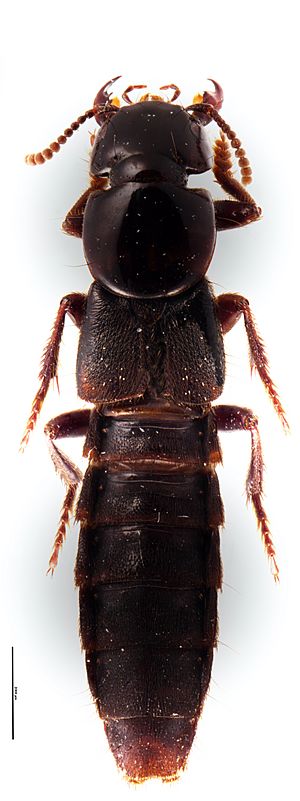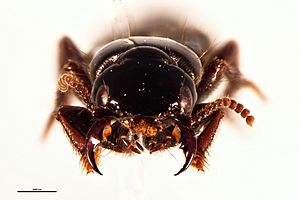Creophilus rekohuensis facts for kids
Quick facts for kids Creophilus rekohuensis |
|
|---|---|
 |
|
| Holotype of Creophilus rekohuensis | |
| Scientific classification | |
| Kingdom: | |
| Phylum: | |
| Class: | |
| Order: | |
| Family: | |
| Subfamily: |
Staphylininae
|
| Genus: |
Creophilus
|
| Species: |
C. rekohuensis
|
| Binomial name | |
| Creophilus rekohuensis Clarke, 2011
|
|
The Creophilus rekohuensis is a special kind of rove beetle. It belongs to the family called Staphylinidae. This beetle lives only on a few small islands in the Chatham Islands of New Zealand. These islands are special because they don't have many predators that could harm the beetle. You can often find them living inside the burrows of seabirds. The beetle's name, rekohu, comes from the Moriori name for Chatham Island.
Contents
How This Beetle Was Found
People first noticed this beetle way back in 1924. A scientist named C. Lindsay saw it. Later, a specimen (a collected example) from Mangere was sent to the Canterbury Museum.
In 1993, Rowan Emberson from Lincoln University found two more of these beetles. He found them in a petrel burrow on Mangere Island. Later, in 1997 and 1998, he and John Marris found even more. They looked in burrows, under logs, and in leaf litter on Mangere, Rangatira, and Star Keys islands. They also used special "pitfall traps" to catch them.
The main example specimen, called the holotype, was collected in 2006. David Clarke and M. Renner found it in Woolshed Bush on Rangatira Island. This important specimen is now kept at Lincoln University's Entomology Research Collection. Other examples, called paratypes, were sent to the Field Museum and the New Zealand Arthropod Collection.
What Does C. rekohuensis Look Like?
When Rowan Emberson first saw this beetle, he noticed it looked a lot like another New Zealand beetle, C. huttoni. But there was a key difference: the tiny hairs on C. rekohuensis were silver, not gold.
When David Clarke officially described the species, he pointed out some unique features. It has a large, trapezoid-shaped head that is pale yellowish-brown behind its eyes. Its antennae (feelers) have an unusual last segment. Also, the last part of its front feet is smaller than usual. Unlike most other Creophilus beetles, the males and females of C. rekohuensis seem to be about the same size.
Clarke also found that this beetle has very small wings. This means that, unlike most rove beetles, C. rekohuensis cannot fly! Even though it can't fly, if it gets scared, it still tries to fly. It will spread its tiny wings while running away.
Where Does It Live?
C. rekohuensis has only been found on small islands southeast of Chatham Island, New Zealand. Scientists have collected specimens from Mangere Island, Pitt Island, and a tiny island near Pitt Island called Rabbit Island. They've also found it on Star Keys and Rangatira Island. Most of the beetles have been found on Rangatira Island.
On Rangatira Island, these beetles seem to prefer living in coastal broadleaf forests. These forests have trees like Myrsine, Pseudopanax, and Coprosma. The ground in these forests is full of burrows made by seabirds like white-faced storm petrels, diving petrels, and broad-billed prions. The forest floor in these bird colonies is often hard and doesn't have much leaf litter. But C. rekohuensis can find shelter inside the bird burrows. It also lives in coastal areas with plants like Sarcocornia and Disphyma.
What Does It Eat?
Most Creophilus beetles are "carrion feeders." This means they eat rotting meat and the maggots (larvae) that live on dead animals. Both adult beetles and their young (larvae) eat this way. However, scientists have only seen C. rekohuensis eating carrion once.
On Rangatira Island, seabirds that die are quickly eaten by other creatures. Two types of native wētā (large insects) called Talitropsis megatibia and Novoplectron serratum are very good at cleaning up dead birds, leaving only skeletons.
Protecting C. rekohuensis
Scientists have tried to find C. rekohuensis on Pitt and Chatham Islands using traps with meat bait. But they haven't found any. This suggests that the beetle only lives on islands where there are no introduced predators. For example, Rangatira Island was used for farming until 1961, but it never had cats, rats, or mice. These animals are a big threat to many native species.
It's possible that this beetle could survive on the main Chatham Island. It might live in seabird colonies that still have their natural forest and where people control rodents. An example is the taiko colony at Tuku Nature Reserve.
Like other beetles on the Chatham Islands that can't fly, C. rekohuensis is in danger if rodents invade its last safe places. However, unlike some other species, this beetle doesn't have any official protection under the Wildlife Act 1953. The Department of Conservation hasn't yet looked at its conservation status. This means there isn't a special plan to help this unique beetle survive.


